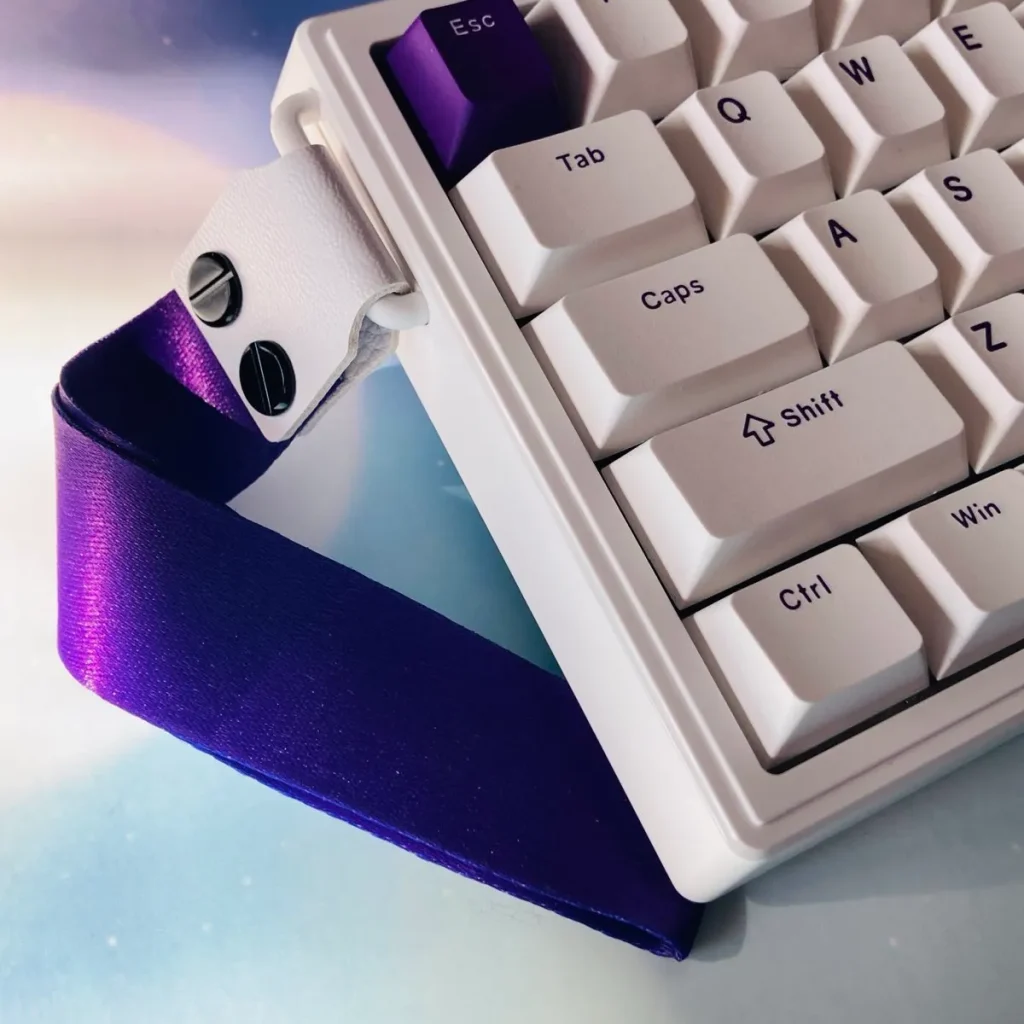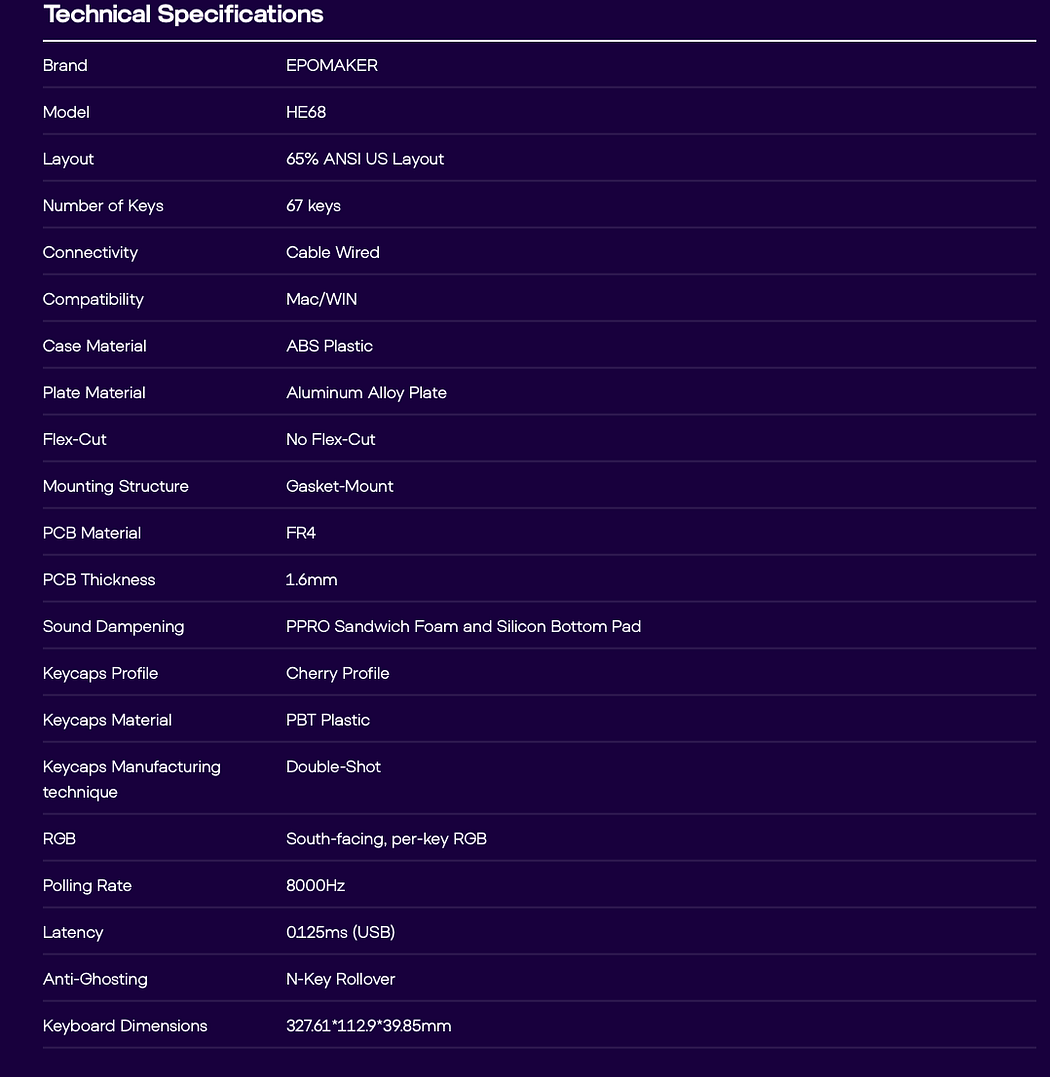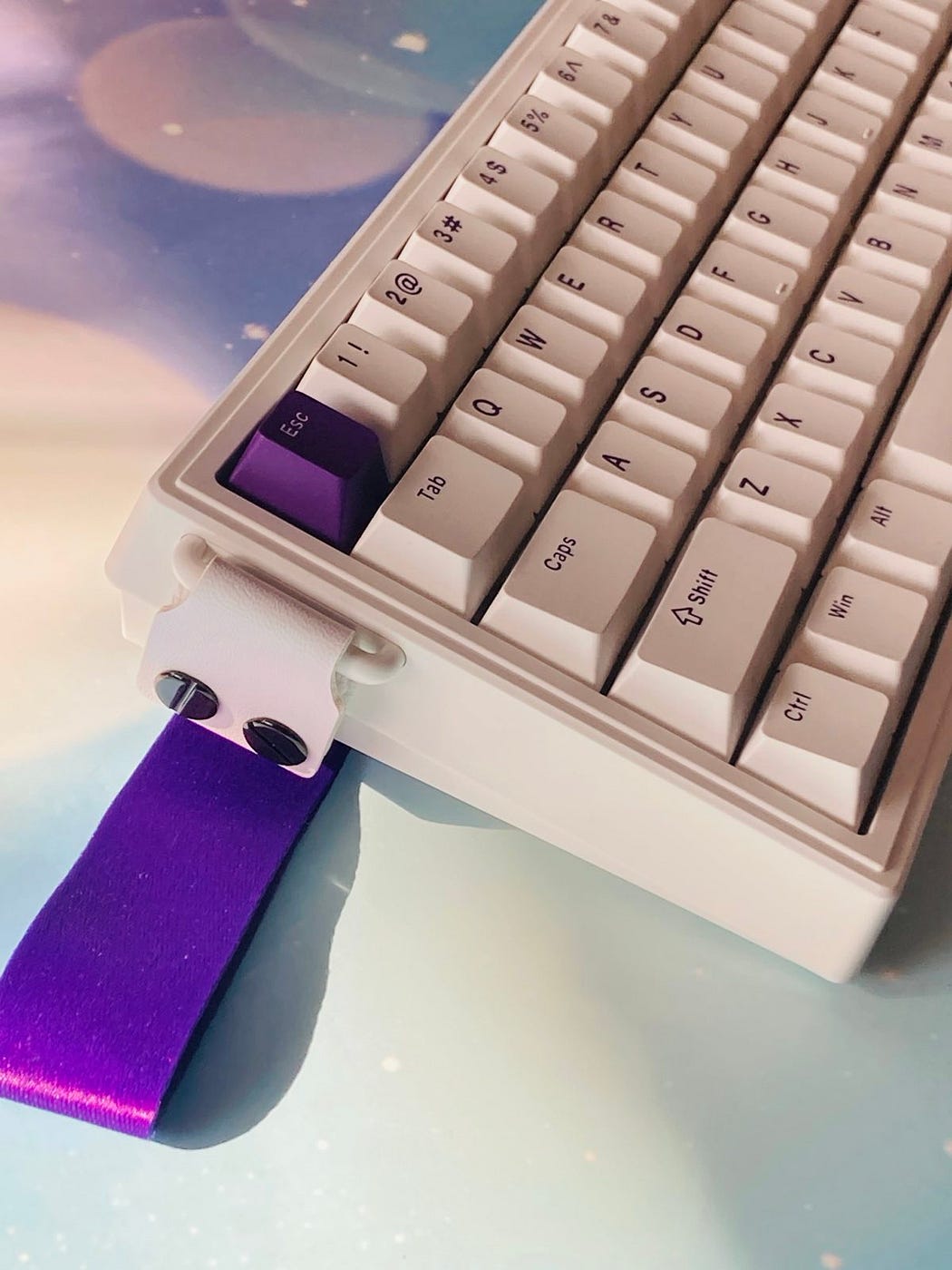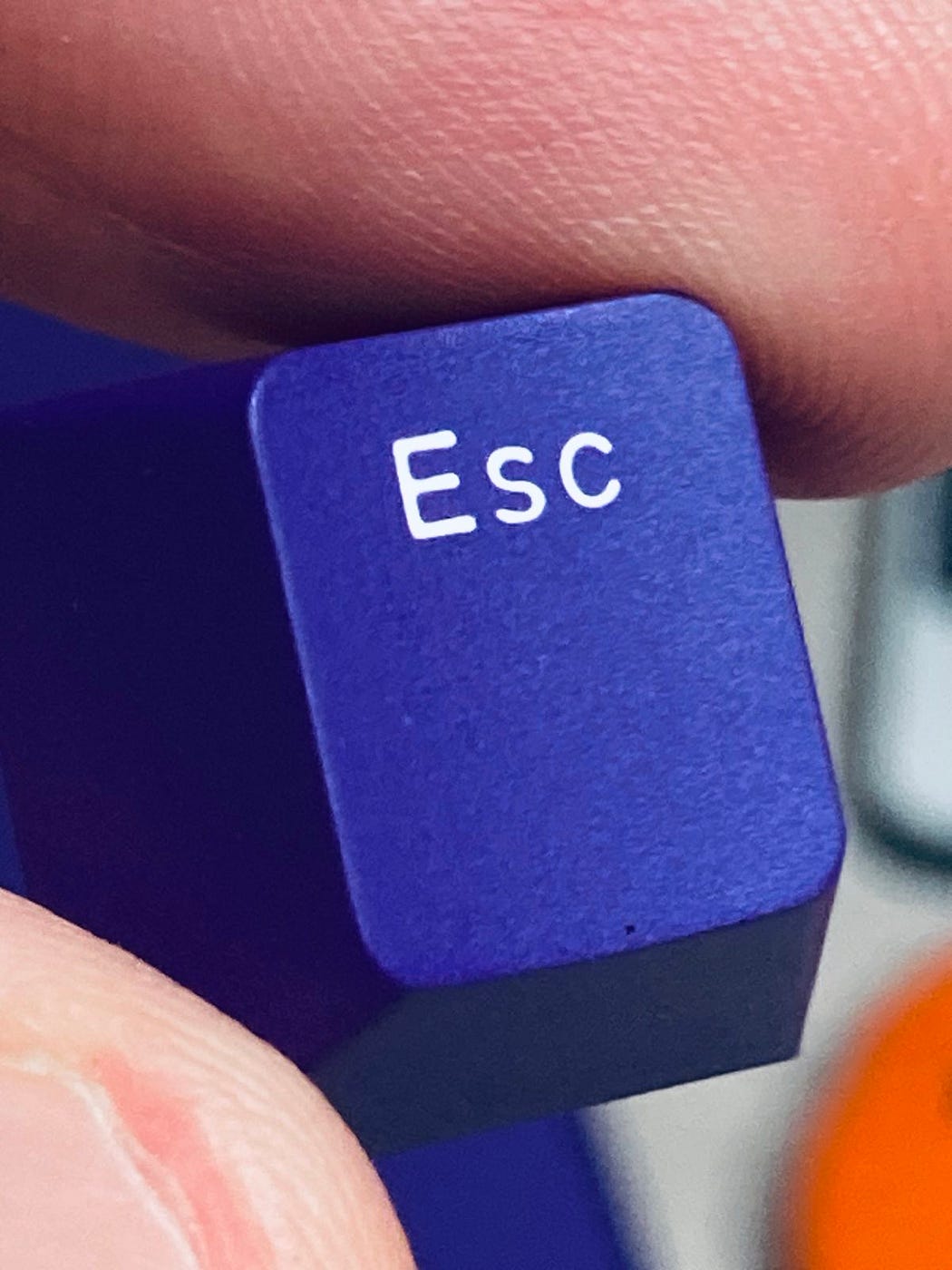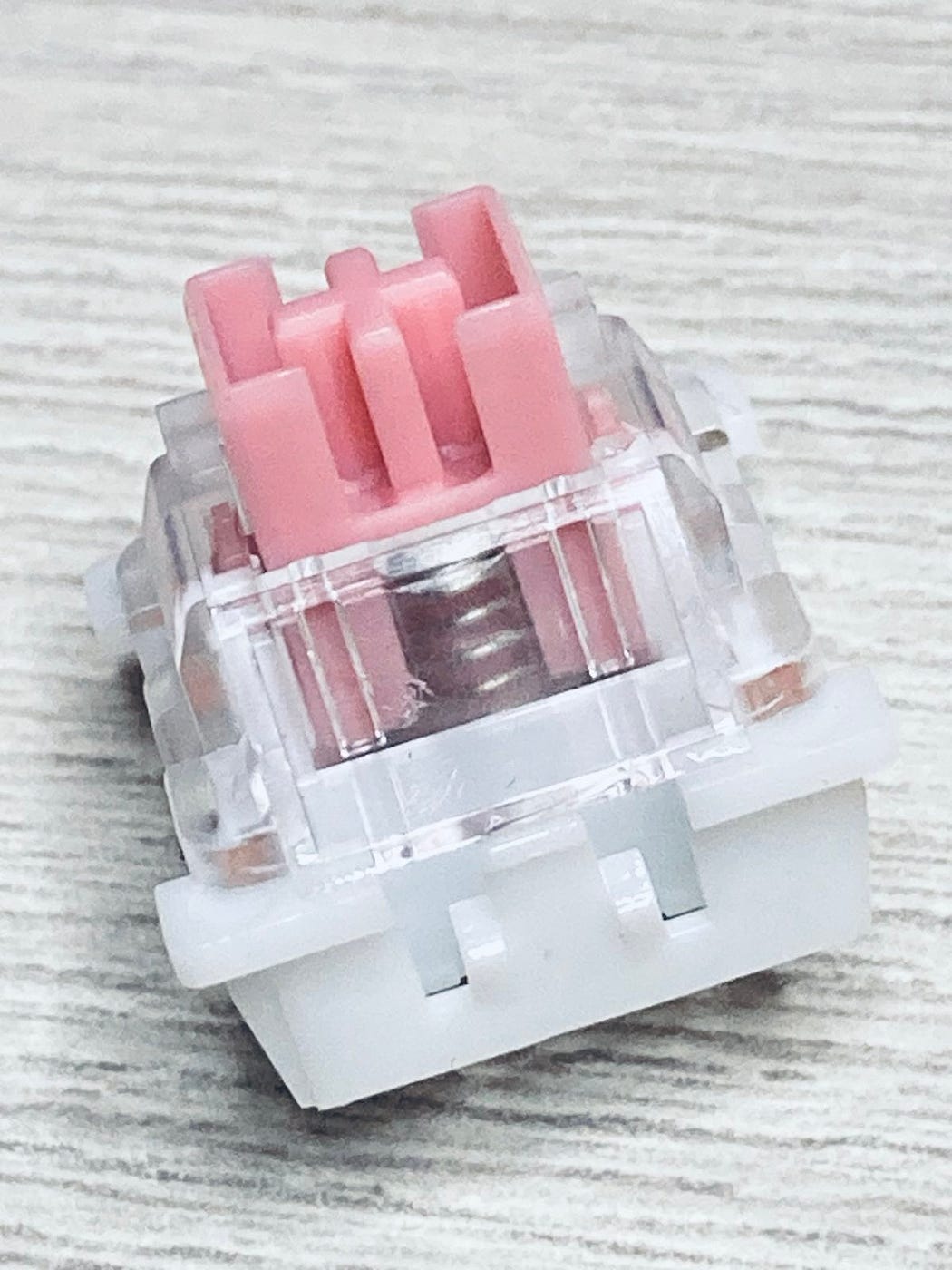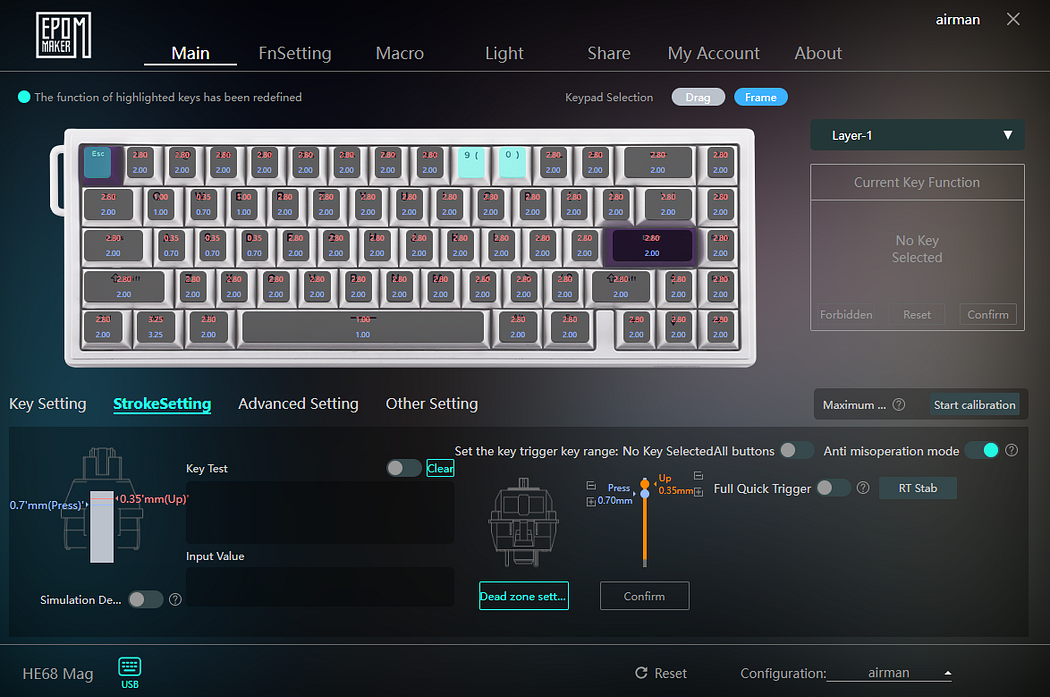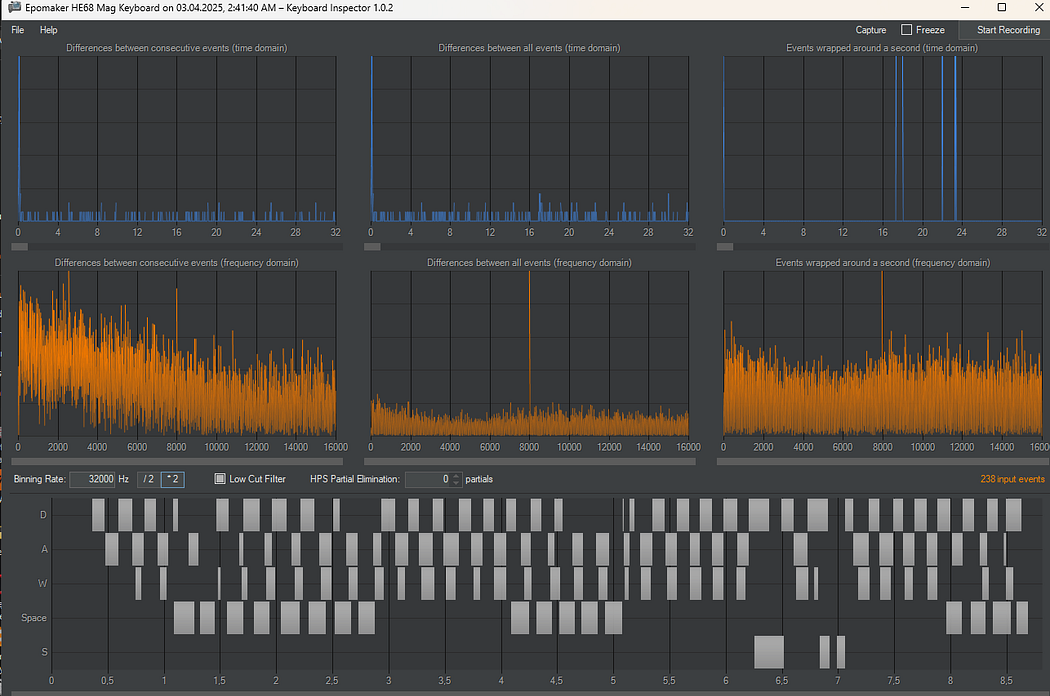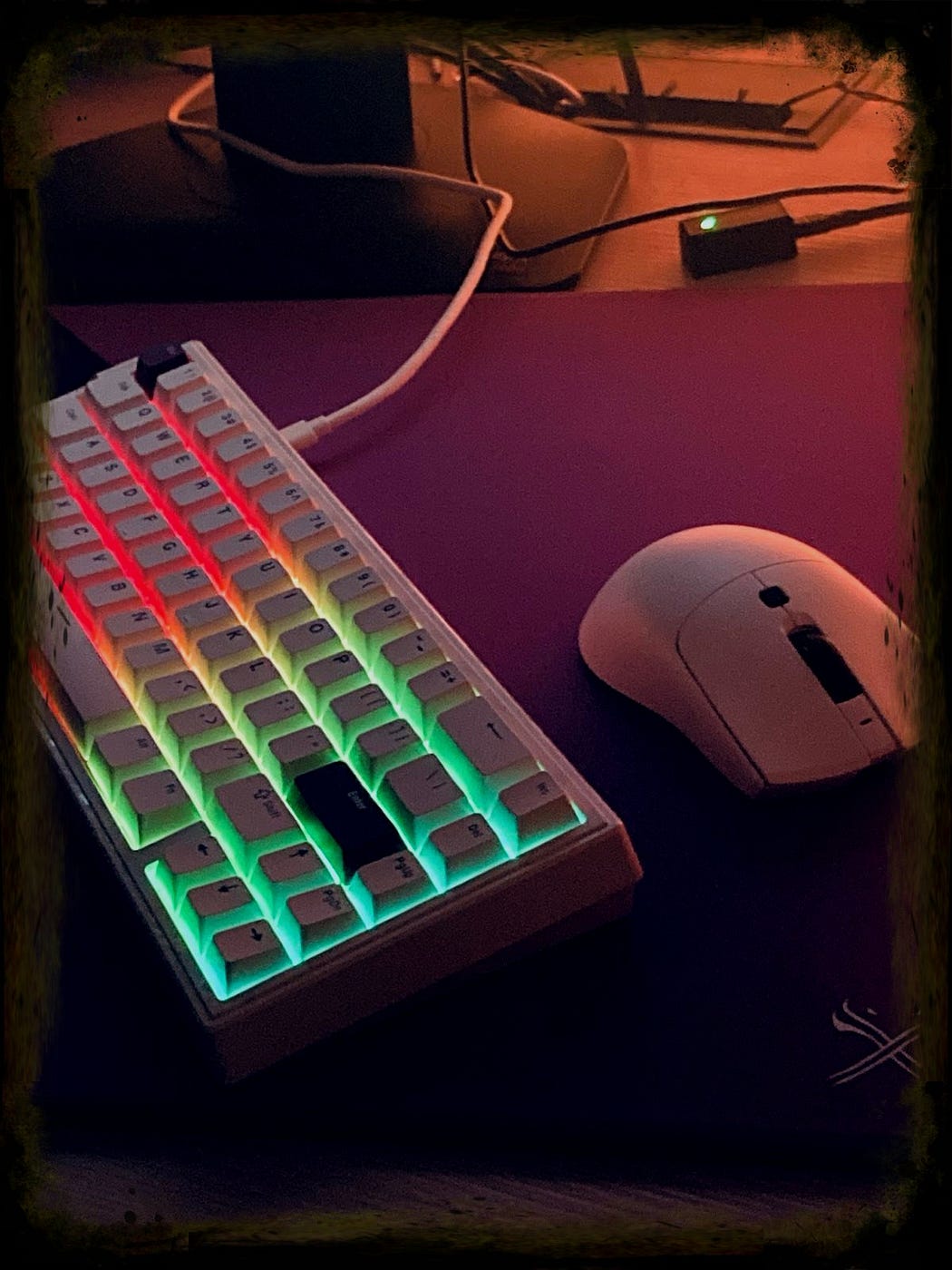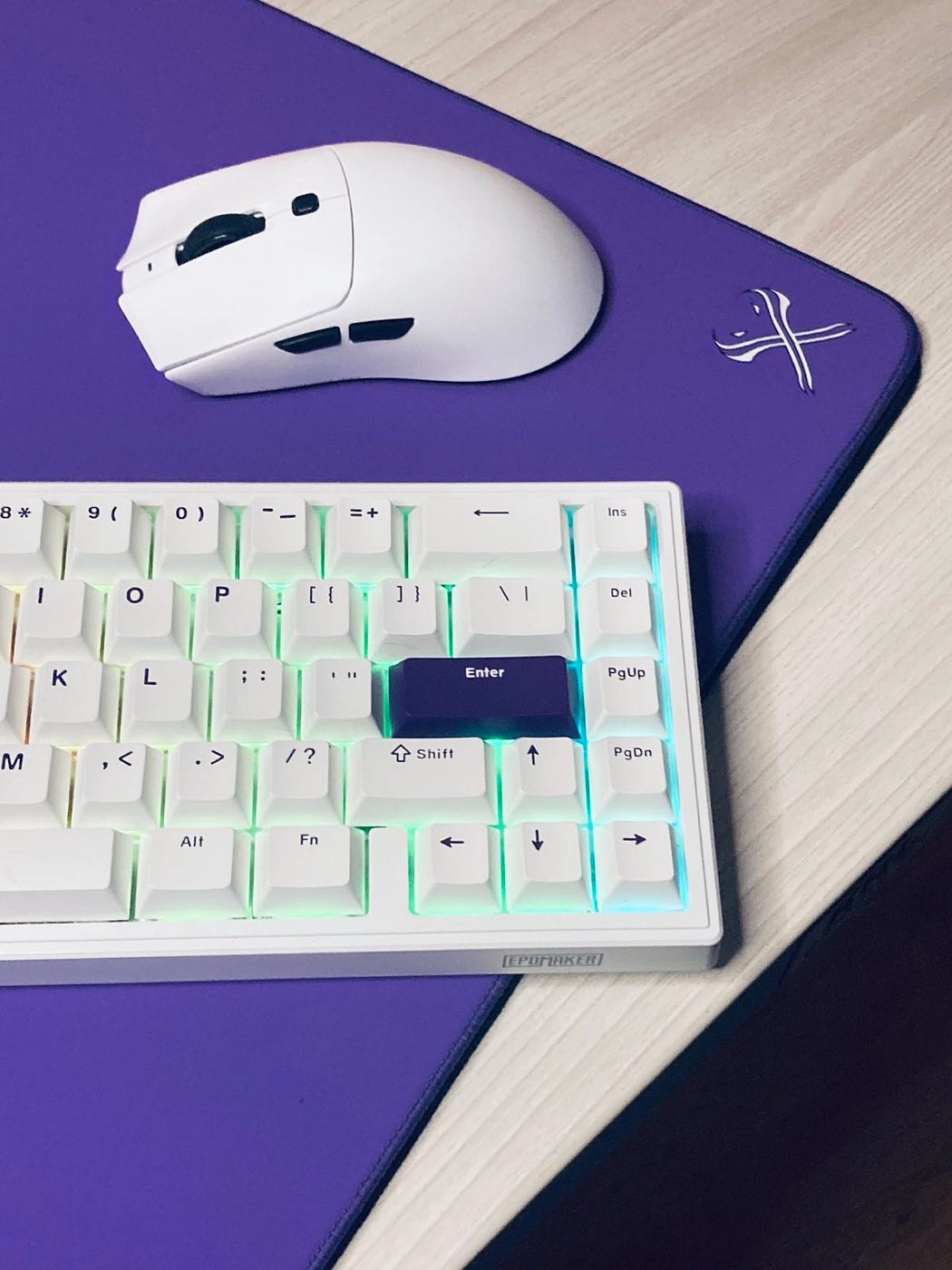Epomaker, a Chinese brand specializing in mechanical keyboards, has recently ventured into the realm of magnetic and inductive keyboards. The Epomaker HE68, their latest offering in this growing lineup, joins the fleet as an affordable contender in the popular 65% layout. Priced lower than many comparable magnetic keyboards on the market, it delivers a compelling mix of style and performance for budget-conscious enthusiasts. Here’s a closer look at this sleek, strong, and cost-effective addition to Epomaker’s portfolio.
Disclaimer: this unit was sent out to me for testing purposed, however, Epomaker had no influence on this review. Since it’s a pre-production unit, your experience may vary.
In the Box
The unboxing is very simple, the box looks rather cheap and can be easily dented, which happened to my copy. The keyboard is wrapped in a plastic sleeve. Inside, you will find the following:
- Epomaker HE68 Keyboard with a strap attached to the left side of the board
- USB-A to C braided cable
- Plastic Keyboard Cover
- User Manual
- Keycap/Switch Puller
- 2 spare Epomaker Magnetic switches
Bottom line? Pretty standard, absolutely default unboxing and contents.
Specs
More and more good quality magnetic keyboards show up, some with really affordable price tag and this one is one of them — I like the gasket mount and 8k polling rate here.
Bottom line? Really good specification at this price range.
Design and Build Quality
The Epomaker HE68 is a standout in the budget mechanical keyboard market, blending sleek design with solid build quality. Its compact 67-key layout (65% ANSI US) is housed in a gasket-mounted frame, delivering a satisfying typing experience with a subtle flex that enthusiasts will appreciate. The keyboard sports a stunning white-and-purple color scheme — a slick, eye-catching combo that arguably makes it the prettiest option in its price range. There’s also a black-and-red variant, but the white-purple version exudes a tidy, neat, and effortlessly cool aesthetic that’s hard to beat.
The case is crafted from high-quality ABS plastic, which feels surprisingly premium despite its lighter weight. At a glance, it could even pass for aluminum, though the heft reveals the truth. This plastic construction doesn’t compromise durability or cheapen the feel — sharp edges and thoughtful design elevate its presence. Inside, Epomaker includes PPRO Sandwich Foam and a Silicon Bottom Pad, dampening noise and enhancing the typing feel with a soft, cushioned response. The keycaps, with crisp printing and vibrant coloring, further sharpen the board’s striking look.
Functionally, the HE68 keeps it simple with a wired-only connection — no wireless bells or whistles here. It features a Win/Mac toggle switch at the back for easy OS compatibility, adjustable feet for ergonomic typing angles, and an aluminum plate at the rear for added rigidity. A quirky yet charming detail is the small strap on the left side, remind us of Wooting 60HE.
Priced affordably, the HE68 punches above its weight. The combination of its gorgeous white-purple finish, sturdy build, and refined typing experience makes it a home run for Epomaker. Every glance at this keyboard reinforces its value — beautiful, practical, and absolutely worth it.
Bottom line? The white/purple version is stunning.
Keycaps
The Epomaker HE68 Cherry profile keycaps are a standout feature of this keyboard, and easily one of my favorite aspects. These keycaps, roughly 1.5mm thick, are crafted from durable PBT plastic, giving them a solid, premium feel. What really sets them apart is their texture — grippy yet delightfully chalky, offering a satisfying tactile experience with every press. In the white and purple colorway, they’re not only slick to the touch but also visually striking, adding a sleek, pretty aesthetic that elevates the entire typing experience.
For some reason, they didn’t develop almost any shine on the most used keys, something that is very rare to see. Good work.
Bottom line? Pretty, slick and aesthetically pleasing. Grippy, chalky feeling, they didn’t develop any shine which is amazing.
Switches
Epomaker features their Magnetic Pink Switch here. Some specs below:
- Total Travel: 3.5mm+/- 0.1mm
- Force Travel: 45+/-5gf
- Initial Force: 30gf min
- End Force: 55gf max
- Initial Magnetic Flux: 95+/-15 gs
- Bottom Magnetic Flux: 580+/-50 gs
The switches in the Epomaker HE68, produced by Epomaker themselves, bring a distinct character to the keyboard. They’re noticeably heavier to press than something like Jade Pro switches, which might appeal to those who prefer a firmer actuation. Designed as box-mounted switches, they offer solid stability, and their closed-bottom construction ensures the factory-applied lube stays put — though, in my opinion, they could’ve been more generously lubed for an even smoother feel. Compared to some competitors, they’re a tad scratchier, but it’s not a dealbreaker for me. They get the job done reliably, striking a balance between function and that unique Epomaker flair.
Bottom line? They get the job done, are a bit on the heavier and more scratchy side though.
Typing Experience and Sound Test
The Epomaker HE68 offers a distinctive typing experience shaped by its unique construction and design choices. Featuring a body primarily made of PBT plastic with an aluminum alloy plate, this gasket-mounted keyboard is fortified with internal foam to dampen vibrations, though it remains notably rigid with no flex during use, resulting in a slightly stiff typing feel. The box-mounted switches, pre-lubed for smoother action, and well-implemented stabilizers contribute to a stable keystroke, minimizing wobble. However, the typing sensation carries a hint of scratchiness, and the sound profile leans toward a hollow tone, which might not appeal to everyone.
Personally, I find these quirks negligible, as my attention is drawn to the grippy ABS keycaps that deliver a delightful, almost “chalky” texture I thoroughly enjoy. The keyboard stabilizers also do their work well, and the spacebar is very stable and a real pleasure to use. Overall, typing on the HE68 is a pleasure, despite the occasional typo, making it a satisfying choice for my preferences.
Bottom line? Chalky PBT keycaps are pleasant to use, typing experience is good, but a bit clacky.
Software and Features
The software is where Epomaker still has work to do. It covers most crucial features, but it’s not complete and has its fair share of bugs and shortcomings. But it is actually the only thing that I could nitpick on, so lets do it.
As always, I strive to find the perfect customization software, though such a thing seems elusive. The Epomaker HUB, required for configuring the HE68, must be downloaded rather than being web-based, which would have been more convenient. Since the HUB is a universal platform for multiple Epomaker devices — including the Click Mouse, which I previously reviewed — it can feel somewhat bloated if you only need it for a single device.
While the software is functional, it has its downsides. The UI is unintuitive, and terminology deviates from established industry standards, likely due to poor translations. This can be particularly confusing for users new to magnetic switch keyboards. Sharing profiles also seems to be broken or at least unreliable — the system doesn’t confirm if you’ve successfully shared or loaded a profile, which is frustrating.
That said, the software does include a solid range of working features. Core functionalities like SOCD (Simultaneous Opposing Cardinal Directions), Mod Tap, DKS (Dynamic Keystroke), TGL (Toggle Key), macros, layer configuration, RGB customization, and RT stabilization all work well. The RT stabilization algorithm helps maintain consistency by slightly increasing latency when actuation exceeds 50%, and the so-called “anti-misoperation mode”(did I mention the quirky names?) helps compensate for accidental misinputs. While the software is far from perfect, once properly configured, it allows for a highly customizable typing and gaming experience. And it also allows you to customize the switch Dead Zone, which is a very useful feature.
Bottom line? The Hub does things right, but it lacks better UI, better features translations and external profiles management.
Latency and Gaming Performance
The Epomaker HE68 delivers impressive gaming performance, thanks to its true 8,000Hz polling rate and a powerful microcontroller unit (MCU) that ensures minimal input delay. During testing at the most sensitive settings, single key press latency consistently measured around 0.5ms, placing it among the fastest gaming keyboards in its price category.
While the overall latency was slightly higher — by a few milliseconds — compared to top-tier competitors such as Wooting, Nuphy, Iqunix, and Melgeek, this variance remains negligible in real-world gaming scenarios. In fast-paced gameplay, the HE68 felt highly responsive, enabling precise execution of complex inputs. The immediate actuation and feedback were particularly noticeable in trick maps and fast-twitch gaming, where split-second reactions are crucial.
Beyond raw speed, the switch stability stood out as a key advantage, providing a consistent and satisfying keystroke feel. The high-quality switches, coupled with the keyboard’s well-implemented actuation system, contributed to an intuitive and immersive gaming experience. Despite minor software bugs, the overall software performance remained functional and reliable, making the Epomaker HE68 an excellent choice for competitive and enthusiast gamers seeking top-tier responsiveness at a competitive price.
Bottom line? Very responsive, very stable, real joy to game with.
Summary
I am impressed and very satisfied with this keyboard. To me, this compact, feature-packed gaming keyboard combines top-tier performance with a visually stunning design. Its white and purple color scheme exudes a clean, neat, and almost elegant aesthetic, further enhanced by a fun purple carrying strap that adds a playful touch. My favorite chalky-textured keycaps provide a wonderfully satisfying feel, elevating the typing and gaming experience. Despite the keycaps being non-shine-through, the keyboard’s impressive RGB lighting still manages to shine brilliantly in the night.
From a performance standpoint, the true 8,000Hz polling rate and low latency make the HE68 a fantastic choice for gaming, rivaling some of the best keyboards in the market. Key presses feel instantaneous, and the overall responsiveness allows for precise and fluid gameplay, making it a standout option at its very affordable price point.
However, its only real drawback is the software. The driver is not web-based, suffers from poor translations, and lacks clear explanations for its various features. A more user-friendly and intuitive interface would greatly improve the overall experience. That said, this is the only weak spot in an otherwise exceptional keyboard, making the Epomaker HE68 a must-check option for gamers and enthusiasts looking for high performance without breaking the bank.
Bottom line? Just get it, despite the software shortcomings and quirky UI.
Bullet Points
- great keyboard for this price tag
- very pleasant (grippy and chalky) keycaps that develop almost no shine for quite some time (white keycaps preferred)
- good and stable switches that are a bit on the heavier side
- beautiful design and colors (especially white/purple version)
- pleasant typing experience, wrist rest is not necessary
- very good south-facing RGB that delivers even without shine-through keycaps
- software is not web-based, it’s the Epomaker Hub…
- … that needs work and better translation because they are a bit misleading to a new user
Get this real deal at the Epomaker site (no affiliation)
Disclaimer: this review is not a paid endorsement. I want to ensure transparency and let you know that I am not receiving any compensation, monetary or otherwise, for evaluating or discussing this tech product.

